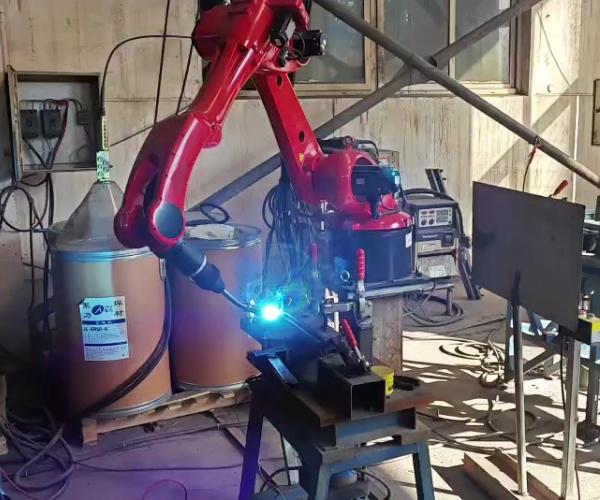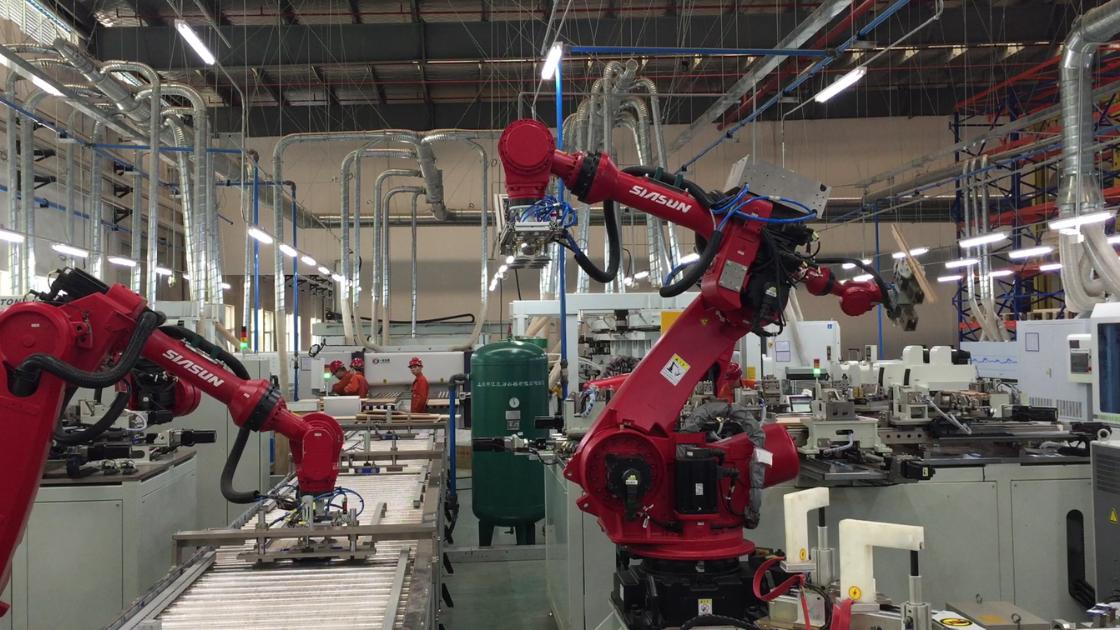TL;DR:
- Welding robots are a key part of modern production lines, eliminating human error and improving weld quality.
- They consist of a robotic arm, energy source, control system and fixtures, allowing precise manoeuvring.
- Operation does not require specialised skills; operators take care of loading and unloading.
- It is possible to build a production line to automate the loading and unloading of components.
- Automation increases efficiency, reduces costs and improves workplace safety.
- The popularity stems from efficiency, cost reduction and the ability to work in harsh environments.
- Welding robots are used in the automotive, aerospace and mechanical engineering sectors, ensuring high quality welds.
- The automation trend is driven by the development of robotisation, particularly in the heavy industry and the automotive industry in Poland.
Considering the introduction of welding robots into your facility? Knowing how they work and their benefits can bring a revolution to your production. Welding robots are the future of industry: they improve quality, increase efficiency, and reduce costs. Understanding these technological marvels will enable you to maximise productivity and stay ahead of the competition. Read the article to discover how welding automation can change the face of your business.
How do welding robots work?
Welding robots are an integral part of modern production lines. How does such a robot work? The key to understanding how it works is the technology that drives the automation of welding processes. A robotised welding station equipped with a Siasun robot, precisely controls the welding movements, eliminating human error. This achieves repeatability and weld quality, which is impossible with manual welding. The role of technology in automation is invaluable, providing precise welding parameter settings for different materials and shapes.
Elements and mechanisms of action
Each welding robot consists of several key components: the robot arm, the welding power source, the control system and the specialised accessories. The arm, often multi-axis, allows precise manoeuvring in hard-to-reach areas. The control system is responsible for programming and controlling the welding process, allowing it to adapt to individual production needs. Automation also reduces operators' exposure to harmful working conditions, improving the safety of the overall working environment.
Operation by unskilled operators
Do welding robots require operators to have specialised skills? Not necessarily. Operating these machines has become intuitive. Familiarity with the basic functions is sufficient and the rest of the process is controlled automatically by the robot. The robotised welding station performs the welds independently, while the operators focus on loading and unloading the parts. This avoids errors associated with human inattention or fatigue.
Our company also builds entire production lines that eliminate the need to load and unload parts, thus significantly speeding up the production process.
Popularity of robotic solutions
Why are welding robots gaining in popularity? Primarily due to increased efficiency and reduced production costs. Automation allows for faster work rates, increased productivity and consistency in weld quality. Robots can tackle repetitive tasks with ease, making them ideal for long and high volume production cycles. Thanks to robotised welding workstations, modern factories can achieve a competitive advantage in the market.

What are the advantages of welding robots in industry?
Welding robots are an integral part of modern industry with numerous benefits. One of the main advantages is the significant improvement in welding quality and accuracy. Automation of welding processes eliminates errors due to human fatigue, resulting in consistent weld quality and increasing productivity by up to three times.
Improving welding quality and accuracy with robots
Robotised welding workstations allow reproducible and precise results to be achieved by dynamically adjusting the welding parameters. As a result, even unskilled operators can operate these systems, dealing only with the loading and unloading of components.
Reducing costs and increasing production efficiency through automation
Using welding robots also saves costs. Thanks to operational efficiency, the return on investment in such solutions is often within 18-22 months. Reducing waste and material consumption also reduces operating costs. It is worth emphasising that Automation Michale offers comprehensive welding automation solutions that speed up production and reduce costs.
Occupational safety and reduction of risks associated with manual handling
Welding robots improve occupational safety by minimising human contact with hazardous conditions such as toxic gases. They avoid many of the hazards associated with manual handling, which in turn enables better use of human resources in other areas of production.
All these advantages make the investment in welding robots a strategic move, increasing the competitiveness of companies in the market. With a combination of quality, economy and safety, welding robots are a key component of modern production lines.

What are the types and uses of welding robots?
In the industrial world, welding robots are true heroes. They enable precise and reproducible work, while increasing safety on the jobsite. Thanks to robotised welding workstationsWe can speak of a revolution in welding that is transforming the face of the entire industry. It is therefore worth understanding what types they are and how and where they can be used.
Types of welding robots and their unique features
Welding robots are divided into several types, each with its own specific applications and features. The most common are arm robots, which allow great flexibility in difficult production environments. We also have robots dedicated to spot welding and collaborative robots, which allow for shoulder-to-shoulder work with humans for safety and ease of use.
Applications of welding robotics in various industries
In many industrial sectors, such as automotive, aerospace and mechanical engineering, welding robots are crucial. They make it possible to weld parts with complex shapes and ensure consistent quality. In automotive, for example, they can perform welds on car bodies, a task that requires high precision and repeatability.
Overview of robotic welding workstations - features and benefits
Robotised welding workstations offer many benefits. First and foremost, they ensure welding consistency and accuracy, reducing the risk of human error and minimising workers' exposure to harmful conditions. Thanks to automation, it is possible to adjust welding parameters in real time, resulting in almost 100 per cent repeatability and detail in welds. As a result, welding robots help to improve productivity and reduce production costs.
How to choose the right welding robot?
Choosing the right welding robot is not an easy task. The key features to consider are not only technology, but also compatibility with existing production processes and systems. So what are the key challenges of manual welding and how can robotic solutions overcome them? Often, these include a lack of repeatability, poor quality and productivity, and a shortage of skilled workers, all of which can be easily overcome with precise and dynamic robotic systems.
Criteria for the selection of a welding robot, taking into account production needs
A fundamental factor in selecting a welding robot is to analyse the specific requirements of production. It is worth considering which type of robot best suits the characteristics of the materials to be welded and the requirements for accuracy, speed and scale of production. It is also necessary to examine what welding techniques are available, such as TIG, MIG or spot welding, that the robot can perform, and what integration needs exist with other operating systems.
Assessment of compatibility with existing systems and processes
Compatibility with existing systems is another key aspect. It is important to ensure that the chosen robot can interact with the technologies already in use and that seamless integration will be possible. It is important that robotic welding workstations are tailored to specific production requirements, allowing new equipment to be fully utilised within the current infrastructure.
Investment and maintenance cost analysis of the welding robot
Investing in a welding robot also requires a careful cost analysis. It is not only the purchase price that needs to be considered, but also the maintenance costs and potential savings in the long run. Welding robots, such as those offered by the Automation Michalecan pay for themselves in just a few months, thanks to significant improvements in production efficiency and quality. The cost-saving gains in terms of reduced risk of errors and unified production can be substantial.
What does the future of robotic welding look like?
The future of robotic welding promises to be exciting. But what are the predictions for the welding robot market? Experts predict a dynamic development, with an increasing share of robots in industrial production lines. In Poland, as well as worldwide, the growing trend towards automation of welding processes is discernible. Robots offer a significant increase in efficiency and a reduction in operating costs, which makes them an extremely attractive solution.
Trends in welding automation
Industry is increasingly turning to automation, seeing it as an opportunity to improve the quality and repeatability of production. Robotic welding stations allow results unachievable by traditional manual methods. High precision and consistency of results help companies become more competitive in the market. Integration with existing systems is now easier than ever before.
Technological innovation is the next milestone that is changing the industry. How will this integration impact? Robotisation allows welding parameters to be adjusted autonomously, providing even greater accuracy and reducing the need for human intervention. This means less downtime and greater productivity.
Robot development in Poland
In Poland, the development of welding robots is particularly evident in the automotive and heavy sector. Automation is becoming not only a way to reduce costs, but also to meet the growing demand for high-quality products. Scalability and flexibility are the keys to success in a dynamically changing market.
Expanding and upgrading robotic infrastructure are investments that bring tangible benefits to organisations. The future belongs to those who can exploit these trends effectively.
Summary
Welding robots are revolutionising the industry, reducing costs and improving quality and safety. Mastering the technology assists unskilled operators and provides a rapid return on investment. The robots in question offer a variety of applications, from improving efficiency to fine-tuning welding parameters. The future lies in full robotisation in welding processes. Choosing the right machine depends on its compatibility with production needs. To outperform the competition, welding robots are an indispensable part of modern production.

